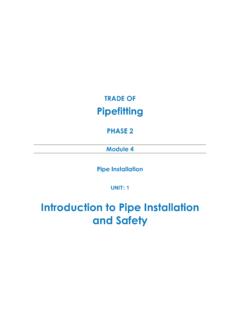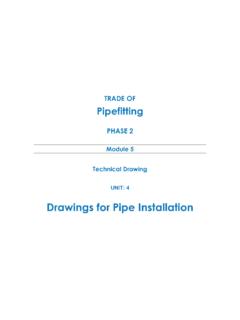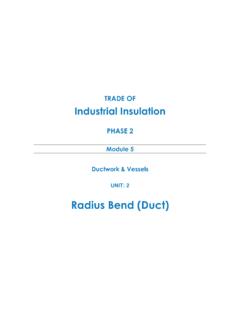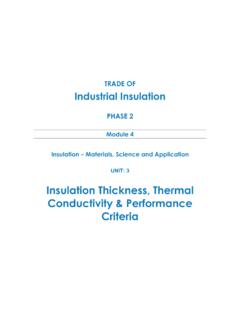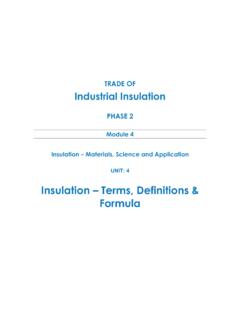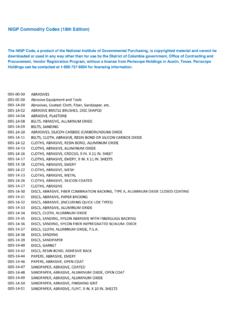Transcription of Pipe Insulation (Hot & Cold) Material Selection & Application
1 TRADE OF Industrial Insulation PHASE 2 Module 1 Sheet Metal and Insulation Fundamentals UNIT: 10 pipe Insulation (Hot & Cold) Material Selection & Application Produced by In cooperation with subject matter expert: Michael Kelly SOLAS 2014 Module 1 Unit 10 Industrial Insulation Phase 2 pipe Insulation (Hot & Cold) Material Selection & Application Revision , August 2014 Table of Contents Introduction .. 1 Unit Objective .. 2 Insulation .. 3 Temperature Ranges .. 3 Insulation Types .. 4 Insulation Forms .. 4 Insulating Materials-Hot and Cold Applications .. 4 Health and Safety .. 7 Hazards .. 7 Safety Precautions .. 7 Understanding a Typical Works Specification .. 9 Scope .. 9 General Conditions .. 9 Material Specification ..10 Application Specification ..10 Application of Insulation Material to pipe Work .. 11 Installing Insulation on New pipe Work ..11 The Slip-On Method ..12 The Snap-On Method.
2 13 Installing ArmaTuff ..13 Vapour Summary .. 16 Module 1 Unit 10 Industrial Insulation Phase 2 1 pipe Insulation (Hot & Cold) Material Selection & Application Revision , August 2014 Introduction There are many insulating products on the market today which cover all temperature ranges and all conceivable installation situations. Although there are too many products to mention, it is important that the apprentice has a good understanding of some of the different products available and their applications. The apprentice must have a grasp of the correct method of Insulation construction and be able to understand a works specification. Module 1 Sheet Metal & Insulation Fundamentals Unit 1 Introduction to the Workshop Environment Unit 2 Manual Handling Unit 3 Measuring, Marking & Cutting Out Unit 5 General Allowances for Insulation & CladdingUnit 4 Notching, Folding & Joining Unit 6 Marking, Cutting, Punching, Rolling, Seam Swagingn & Screwing Unit 7 Swaging (Basic) Male/Female & Flange Turning Unit 8 pipe Cladding (Basic) Fabrication & Application Unit 9 Metal Cladding Assembly Work Unit 10 pipe Insulation (Hot & Cold) Material Selection & Application Unit 11 Valve & Flange Box FundamentalsModule 1 Unit 10 Industrial Insulation Phase 2 2 pipe Insulation (Hot & Cold) Material Selection & Application Revision , August 2014 Unit Objective By the end of this unit each apprentice will be able to: Identify Insulation Materials.
3 Identify the hazards associated with Insulation materials. Understand a typical works specification. Apply a section of insulating Material to pipe work. Apply sealant to hot and cold work Insulation . Apply a vapour barrier to cold work Insulation . Module 1 Unit 10 Industrial Insulation Phase 2 3 pipe Insulation (Hot & Cold) Material Selection & Application Revision , August 2014 Insulation Insulations are defined as those materials or combinations of materials which retard the flow of heat energy by performing one or more of the following functions: Conserve energy by reducing heat loss or gain. Control surface temperatures for personnel protection and comfort. Facilitate temperature control of process. Prevent vapour flow and water condensation on cold surfaces. Increase operating efficiency of heating/ventilating/cooling, plumbing, steam, process and power systems found in commercial and industrial installations.
4 Prevent or reduce damage to equipment from exposure to fire or corrosive atmospheres. Assist mechanical systems in meeting criteria in food and cosmetic plants. Reduce emissions of pollutants to the atmosphere. Temperature Ranges The temperature range, within which the term "thermal Insulation " will apply, is from -75 C to 815 C. All applications below -75 C are termed "cryogenic", and those above 815 C are termed "refractory". Thermal Insulation is further divided into three general Application temperature ranges as follows: A. Low Temperature Thermal Insulation (1). 5 C through 0 C - Cold or chilled water. (2). 0 C through -40 C - Refrigeration or glycol. (3). -40 C through -75 C - Refrigeration or brine. (4). -75 C through -275 C (absolute zero) - Cryogenic. B. Intermediate Temperature Thermal Insulation (1). 16 C through 100 C - Hot water and steam condensate. (2). 100 C through 315 C - Steam, high temperature hot water.
5 Key Learning Points Identification of insulating materials. Selection criteria of materials for hot and cold work. Insulation requirements for hot and cold work materials. Module 1 Unit 10 Industrial Insulation Phase 2 4 pipe Insulation (Hot & Cold) Material Selection & Application Revision , August 2014 C. High Temperature Thermal Insulation (1). 315 C through 815 C - Turbines, breechings, stacks, exhausts, incinerators. Insulation Types Insulation materials are generally divided into three main types: Fibrous Insulation - composed of small diameter fibres which finely divide the air space. The fibres may be perpendicular or parallel to the surface being insulated, and they may or may not be bonded together. Silica, rock wool , slag wool and alumina silica fibres are used. The most widely used insulations of this type are glass fibre and mineral wool . Glass fibre and mineral wool products usually have their fibres bonded together with organic binders that supply the limited structural integrity of the products.
6 Cellular Insulation - composed of small individual cells separated from each other. The cellular Material may be glass or foamed plastic such as cellular glass, phenolic foam or nitrile rubber. Granular Insulation - composed of small nodules which may contain voids or hollow spaces. It is not considered a true cellular Material since gas can be transferred between the individual spaces. This type may be produced as a loose or pourable Material , or combined with a binder and fibres or undergo a chemical reaction to make a rigid Insulation . Examples of these insulations are calcium silicate and vermiculite. Insulation Forms Insulations are produced in a variety of forms suitable for specific functions and applications. The combined form and type of Insulation determine its proper method of installation. The forms most widely used are: Rigid boards, blocks, sheets, and pre-formed shapes such as pipe Insulation , curved segments, lagging etc.
7 Cellular, granular, and fibrous insulations are produced in these forms. Flexible sheets and pre-formed shapes. Cellular and fibrous insulations are produced in these forms. Flexible blankets. Fibrous insulations are produced in flexible blankets. Cements (insulating and finishing). Produced from fibrous and granular insulations and cement, they may be of the hydraulic setting or air drying type. Foams. Poured or froth foam used to fill irregular areas and voids. Spray used for flat surfaces. Insulating Materials-Hot and Cold Applications The following is a general inventory of the characteristics and properties of major Insulation materials used in commercial and industrial installations. Module 1 Unit 10 Industrial Insulation Phase 2 5 pipe Insulation (Hot & Cold) Material Selection & Application Revision , August 2014 mineral Fibre Glass: Available as flexible blanket, rigid board, pipe covering and other pre-molded shapes.
8 Service temperature range is up to 535 C. Rock and Slag: Rock and slag fibres are bonded together with a heat resistant binder to produce mineral fibre or wool . Upper temperature limit can reach 1035 C. Cellular Available in board and block form capable of being fabricated into pipe covering and various shapes. Service temperature range is -260C to 200 C and to 650 C in composite systems. Good structural strength, poor impact resistance. Material is non-combustible, non-absorptive and resistant to many chemicals. Calcium Silicate Calcium Silicate is a granular Insulation made of lime and silica, reinforced with organic and inorganic fibres and moulded into rigid forms. Service temperature range covered is 35 C to 815 C. Flexural and compressive strength is good. Calcium silicate is water absorbent. However, it can be dried out without deterioration. The Material is non-combustible and used primarily on hot piping and surfaces.
9 Finishing Material is applied on site. Expanded Silica or Perlite Perlite is made from an inert siliceous volcanic rock combined with water. The rock is expanded by heating to above 535 C causing the water to vaporize and the rock volume to expand. This creates a cellular structure of minute air cells surrounded by vitrified product. Added binders resist moisture penetration and inorganic fibres reinforce the structure. The Material has low shrinkage and high resistance to substrate corrosion. Perlite is non-combustible and operates in the intermediate and high temperature ranges. The product is available in rigid pre-formed shapes and blocks. Elastomeric Foam Foamed resins combined with elastomers produce a flexible cellular Material . Available in pre-formed shapes and sheets, elastomeric insulations possess good cutting characteristics and low water and vapour permeability. The upper temperature limit is at 105 C.
10 Elastomeric Insulation is cost efficient for low temperature applications with no cladding necessary. Resiliency is high. Consideration should be made for fire retardancy of the Material . Foamed Plastic Insulations produced from foaming plastic resins create predominately closed cellular rigid materials. "K" values or lambda values decline after initial use as the gas trapped within the cellular structure is eventually replaced by air. Check manufacturers' data. Foamed plastics are light weight with excellent cutting characteristics. The chemical content varies with each manufacturer. Available in pre-formed shapes and boards, foamed plastics are generally used in the lower intermediate temperature range. Consideration should be made for fire retardancy of the Material . Module 1 Unit 10 Industrial Insulation Phase 2 6 pipe Insulation (Hot & Cold) Material Selection & Application Revision , August 2014 Refractory Fibre Refractory fibre insulations are mineral or ceramic fibres, including alumina and silica, bonded with extremely high temperature inorganic binders, the mechanical interlocking of fibres eliminates the need for any binder.

